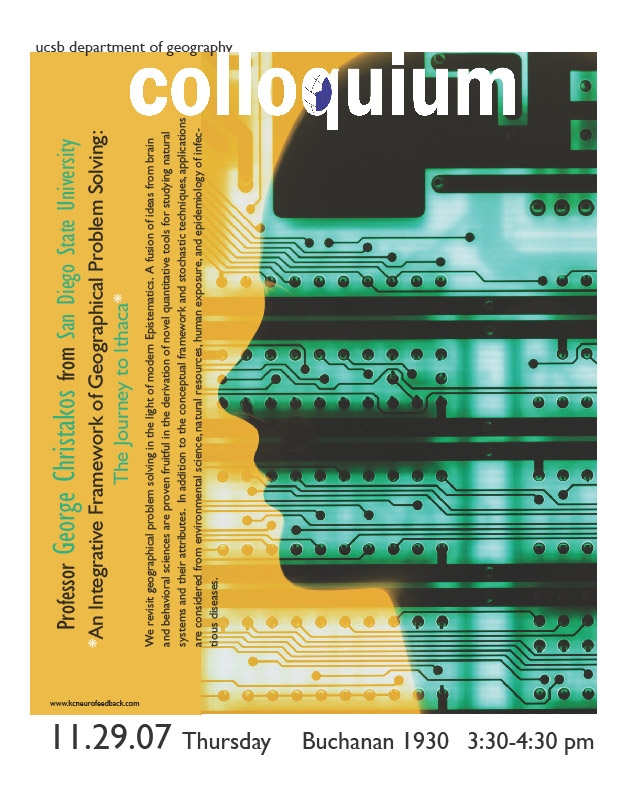The UCSB Geography colloquia series is technically known as Geography 201, “Seminar in Geography,” and is required of all geography graduate students every quarter offered. It consists of a series of seminars on diverse problems in human and physical geography, as well as geographic techniques, by current and visiting faculty and researchers. “Colloquium,” as it is colloquially known today, began in 1979 and was made compulsory for graduate students under the chairmanship of Reginald Golledge (Chair, July 1980 – June 1984).
According to Meryl Wieder, the Department’s MSO at the time (Meryl retired in 2004), “the Geography Colloquium started out as a ‘Speakers’ Program.’ Students and faculty were not showing up, so they turned it into a course for 1 unit credit. Students had to then write a one paragraph summary of the presentation as proof that they attended. Their grade was based on attendance that was ‘verified’ by the paragraph. Faculty were not attending very well and had to be constantly chided about it by the Chair, but at least there was an audience. Conversion of the visiting speakers program into a course became a way that a Chair could provide ‘course relief’ for a faculty member who needed a lighter load” (source: personal correspondence with Meryl).
In a memo to the Geography Colloquia Committee dated September 24, 1992, Professor Golledge provided a sample letter for prospective Colloquia speakers which states: “We are very pleased that you have agreed to participate in the colloquia series of the Department of Geography at UCSB. This series usually meets Thursdays between 3:30 and 5:00 PM. The general format is for the speaker to present material in as interactive a mode as possible for about an hour, followed by open discussion from the floor. We are trying to make the colloquia series appeal widely to all facets of our department and we appreciate your willingness to help us with this aim…The area of your specialty may not lie specifically within one of our designated areas. Our colloquia is designed to enrich the knowledge structures of faculty and students alike, not only by having other experts in our specialty areas address us, but also by inviting distinguished speakers whose interests lie in areas other than those in which we have chosen to specialize. If the latter situation describes your area of interest, we would like to offer the following suggestions:
- Since our faculty and student population is so diverse, covering as it does both physical and social sciences, it would be most appropriate for you to devote the beginning section of your colloquium to a discussion of the broader framework in which your chosen problem lies. This will provide everyone with a common base of understanding needed to get the most from your presentation.
- We are trying to make our colloquia series more interactive. If possible, we would prefer you to adopt an audience challenging presentation format rather than regarding this as an opportunity to present a formal and perhaps narrowly defined discourse.
- In the spirit of (2) above, you should expect questions and comments from the floor at times during your presentation as well as after it.
- In general, you will find your audience to be literate mathematically, statistically, and computationally. However, with such a large population there will inevitably be a considerable range in the confidence of audience members across these skills. We suggest you talk with your faculty sponsor before visiting the campus to get some idea of what level of understanding you may expect to occur in your audience” (source: Golledge’s archived files, maintained by Bill Norrington).
A large number of our colloquia speakers either were or later became luminaries in the Discipline. With that in mind, IT staff members Guylene Gadal and Jon Hall, in conjunction with the editor, Bill Norrington, have created an archive of colloquia presentations on the UCSB Geography web site. The listing of presenters and the titles of their presentations is not complete, but the archive is growing and, where possible, includes an abstract of each presentation, a short bio of each presenter, and any graphics used to advertise the event. We are particularly indebted to alumnus Michael Costanzo (PhD 1985) for providing details regarding 33 colloquia from 1979-1984, and if any other alumni can help fill in remaining gaps, it would be greatly appreciated.
Article by Bill Norrington






